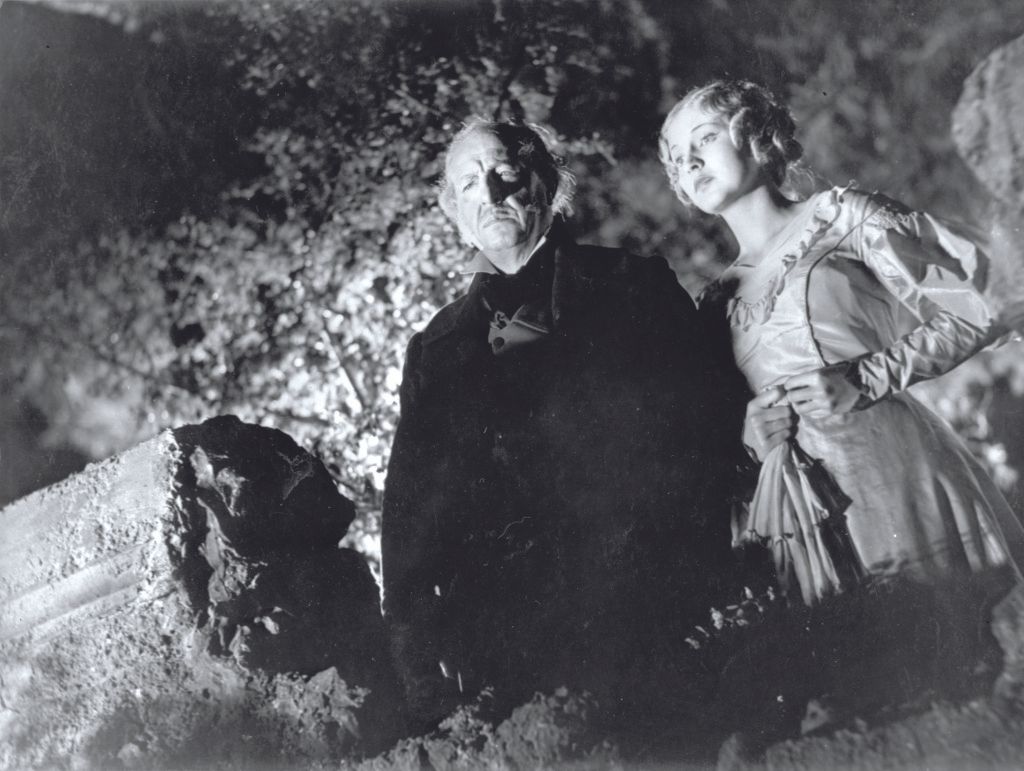
|
Museum Closed, Wednesday, July 4
|
|
Director's Letter
 | |
Last month, I mentioned the intense rivalry that existed between Picasso and Matisse in the early years of the twentieth century. In this, theirs was just the latest in a long line of artistic rivalries going back, in one form or another, to Giotto and Duccio in the fourteenth century. The sixteenth-century Italian painter and biographer Giorgio Vasari recounts with relish the sense of competition between Raphael and Michelangelo. In the nineteenth century, J. M. W. Turner saw himself as besting the seventeenth-century landscapist Claude Lorraine (although, with Claude himself long gone to the great studio in the sky, it's not really a true rivalry), and left his entire estate to the nation on condition that one of his landscapes be permanently displayed in the National Gallery alongside one by Claude so that the British public could see his superiority for themselves. In the nineteenth century, national exhibitions that produced winners, losers, and rejects pitted all artists against one another. In a century where narrative--the story--dominated the visual arts, many artists (mainly the minor ones) carefully guarded their work from others lest their particular theme be "stolen."
There is a tendency to look back on the decades on each side of 1900 as something of a golden age--La Belle Epoque in France, the Gilded Age in the United States--but it was equally a time of unprecedented change when long-held scientific and artistic precepts were challenged in the most fundamental ways. Einstein's First Theory of Relativity overthrew Newton's mechanistic universe at exactly the same time that artists like Picasso, Braque, and Matisse abandoned the idea of a painting as a balancing act between representation and materials and pursued the notion of a painting as primarily an object in and of itself. Picasso famously developed what came to be called cubism in the closest possible collaboration with Braque, likening the two of them to mountaineers roped together. But in 1905, Matisse had established himself as the leader of the avant garde though work that earned him and his fellow exhibitors the epithet Les fauves, or "wild beasts." Matisse and Picasso, as well as others, knew that they were forging a new approach to painting and watched each others' progress like hawks. When Matisse first saw Picasso's break-through painting Les demoiselles d'Avignon, he was profoundly shocked and declared that he would "sink Picasso for this!" He didn't, of course, but went back to his studio and developed a way of making a painting that, though looking more traditional, was parallel to Picasso and Braque's development of cubism. What African sculpture was to Picasso, so North African textiles were to Matisse. If you look carefully at Matisse's still lifes from about 1910, your eye traverses the canvas side to side, top to bottom, guided by brushstroke and color, exactly as Picasso's monochromatic shards do in his still lifes and portraits of the same period. And just like Picasso, Matisse never made the move to pure abstraction that seemed to other artists the logical next step. Picasso once declared that color was of secondary significance for him: "When I run out of blue, I use red," he said. To Matisse--himself a master of line--color was always what it was about: from the paintings that earned him the Fauve title to the late "cut-outs" that work like stained-glass windows.
You can see their struggles--in the end, more with themselves that one another--in the exhibition of their work on paper in the Schwartz Galleries, as well as in the paintings in the second floor modern art galleries. In 1922, the DIA's painting The Window was the first Matisse to be acquired by a U.S. art museum; an anchor in the development of a collection that can now present the careers of two of the twentieth century's most influential artists without borrowing from other collections. More evidence of the enormous value the DIA brings to this region.

Graham W. J. Beal
Back to top |
|

Exhibitions
 Picasso and Matisse: The DIA's Prints and Drawings Picasso and Matisse: The DIA's Prints and Drawings
July 11, 2012-January 6, 2013
Schwartz Galleries of Prints and Drawings
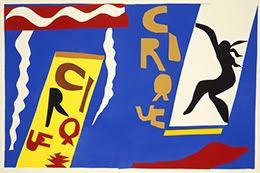 | | |
Henri Matisse, French; Circus, Jazz, Plate III, 1943; pochoir. Gift of John S. Newberry. © 2012 Succession H. Matisse/Artists Rights Society (ARS), New York
| 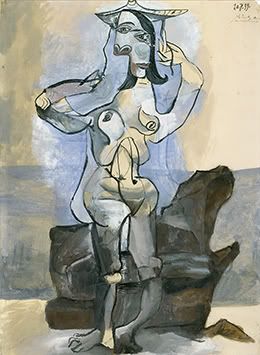 | | |
Pablo Picasso, Spanish; Bather by the Sea, 1939; gouache. Bequest of Robert H. Tannahill. © 2012 Estate of Pablo Picasso/Artists Rights Society (ARS), New York
| |
Pablo Picasso and Henri Matisse were ground-breaking visionaries who constantly experimented with techniques and materials, and the story of their stylistic progressions and artistic ranges are told through the more than 100 prints and drawings in this exhibition. Among the exceptional works on view are Matisse's 1919 drawing The Plumed Hat and Picasso's 1939 gouache The Bather by the Sea. Other highlights include Matisse's famous series Jazz and Picasso's etchings for the Dream and Lie of Franco, as well as many linoleum cuts by both artists.
With the opening of the exhibition, nearly all the museum's holdings of works by the two artists are on view in the galleries. Picasso and Matisse covers the works on paper. The twelve paintings and two bronzes are permanently on view in the museum's modern art galleries. And the thirteenth painting, Picasso's Melancholy Woman, can be found in the exhibition Five Spanish Masterpieces.
This exhibition has been organized by the Detroit Institute of Arts. Support has been provided by Comerica Bank. Additional support has been provided by the City of Detroit.

Above: Henri Matisse, French; The Wild Poppies, 1953; goauche and charcoal. Founders Society Purchase, Robert H. Tannahill Foundation Fund, Friends of Modern Art Fund; Gift of Mrs. Allan Shelden III through the Elizabeth, Allan and Warren Shelden Fund and Gift of Alice Kales Hartwick in memory of her husband Robert G. Hartwick; and public subscription. © 2012 Succession H. Matisse/Artists Rights Society (ARS), New York
Back to top
 Five Spanish Masterpieces Five Spanish Masterpieces
Through August 19, 2012
Special Exhibition Galleries: Central
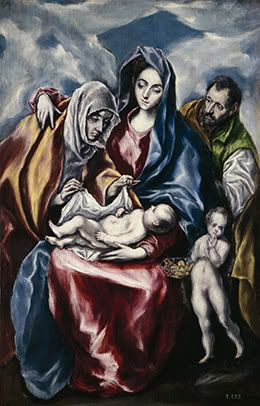 | | |
El Greco, Spanish, born Greece; The Holy Family with St. Anne and the Infant St. John the Baptist, ca. 1600; oil on canvas. Museo Nacional del Prado, Madrid. © Museo Nacional del Prado, Madrid
| |
The paintings in this exhibition represent the summit of Spanish art, from El Greco's The Holy Family with St. Anne and the Infant St. John the Baptist, a perfect example of the artist's mature style, to Salvador Dalí's hallucinatory Soft Construction with Boiled Beans (Premonition of Civil War).
Born on the Greek island of Crete, trained in Italy, and active in Spain, El Greco is considered the most important late Renaissance Spanish painter, renowned for his artistic originality based in the use of vibrant colors, dynamic, open brushstrokes filled with thick impasto (paint mixture), and elongated figures in a narrow space.
Moving to the twentieth century, Spain was on the brink of civil war when Dalí started work on a new painting in 1935. The tortured features and dislocated body parts of the giant in Soft Construction can be interpreted as an allegory of the imminent destruction of the coming war. With Picasso's Guernica, this painting is among the universal icons of protest against the atrocities of war.
For a ten-minute clip of Salvadore Dalí on the old TV game show What's My Line, click here. Click here for Mike Wallace's 1958 fifteen-minute interview with Dalí.
For a work by a sixth Spanish master, check out Francisco de Zurbarán's Apparition of the Virgin to Saint Peter Nolasco of 1628, on loan to the DIA from a private collector and hanging in the European galleries immediately to your right when in the Woodward lobby facing the Great Hall.
On Thursday, July 19, DIA Director Graham Beal discusses how Picasso's Melancholy Woman, one of the five Spanish masterpieces, and other acclaimed works of art, including Caravaggio's Martha and Mary Magdalene and Fuseli's The Nightmare, would rarely be on view in Detroit if the museum granted all the loan requests that come in from around the world. The lecture begins at 6 p.m. and is free.
Back to top
 Patti Smith Patti Smith
Camera Solo
Through September 2
Albert and Peggy de Salle Gallery of Photography
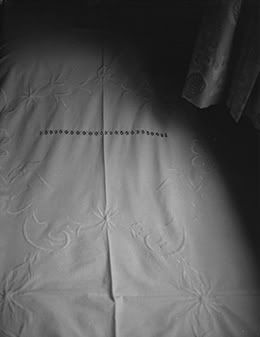 | | |
Patti Smith, American; Virginia Woolf's Bed I, Monk's House, 2003; gelatin silver print. Wadsworth Atheneum Museum of Art, Hartford, CT. Purchased through the gift of Robinson A. and Nancy D. Grover, 2011.18.3. © Patti Smith
| |
In the present era of digital technology and its accompanying media, Patti Smith has embraced vintage photographic equipment and film for the work included in this exhibition. She works with a 1960s Polaroid camera and special film that results in an image that develops instantly after exposure. Smith uses each unique Polaroid as the source for a final print that is made in multiples of ten gelatin silver photographs, a common black-and-white process.
The Polaroid camera is no longer made, and its film is scarce. What remains of Smith's supply of film is sometimes past its expiration date. The idiosyncrasies of the old film and camera can lead to unexpected effects in the resulting image, particularly when combined with the heat of a summer day. Flares and ghostly apparitions add to the mysterious qualities of her subjects, which include the grave sites of nineteenth-century romantic poets Shelley and Keats, and quiet interiors belonging to other writers and artists she admired, including Virginia Woolf and Frida Kahlo.
This exhibition was organized by the Wadsworth Atheneum Museum of Art, Hartford, Connecticut. In Detroit, the exhibition is supported by the City of Detroit.
Back to top |
|
 NEW ON VIEW: PUPPETS NEW ON VIEW: PUPPETS
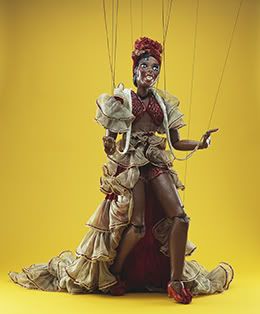 | | |
Frank Paris, American; Josephine Baker, 1937; wood, paint, crushed velvet, cloth, sequins, jewels, and silk. Gift of the artist
| |
Waltz, foxtrot, or jitterbug your way to the puppet cases across from the Lecture Hall to see some of the best examples of American dance marionettes from the museum's Paul McPharlin Puppetry Collection, now on view through the end of the year.
Artists and puppeteers Frank Paris, Lillian Thompson, the Lauer Sisters, and others maneuvered the puppets to entertain adult audiences, particularly in nightclubs and cabarets during the 1930s and 1940s. Such acts often incorporated intricate dancing marionettes based on actual performers, such as singer Josephine Baker, actress and Olympic ice skater Sonja Henie, and the reclusive movie star Greta Garbo.The elaborate, large-scale marionettes were designed to gracefully execute ballet, folk, and modern dance movements by clever use of counter-weighted limbs and finely carved joints.
There's more puppetry for adults Friday, June 13, with the first DIA Moment: PuppetSlam Detroit! at 8 p.m. This series, featuring three to four puppet scenes produced by various puppet artists, kicks off with works from Tom Carey and Dan Tower of Rusty Nail Studio and Naia Venturi of the Dreamland Puppet Troupe performing with hand-crafted marionettes and large-scale shadow puppets.
Dancing Marionettes from the Paul McPharlin Puppetry Collection is sponsored by the Founders Junior Council, a DIA auxiliary for young professionals
Back to top |
|
 Detroit Film Theatre Detroit Film Theatre
DFT 101 continues this month with four films considered essential cinematic masterworks, including King Kong, an instant cultural phenomenon when first shown in 1933. The monstrous ape's lifelike personality continues to enthrall audiences of all ages nearly eighty years after its creation. King Kong plays Saturday, July 7.
During the following three weekends, the action moves to France with showings of Ŕ nous la liberté, the story of an escaped convict who becomes a wealthy, powerful industrialist; L'âge d'or, a surrealistic collaboration between the director Luis Buńuel and artist Salvador Dalí; and Les Misérables, Part I (above), a 1934 film hailed as the greatest screen adaptation of Victor Hugo's nineteenth-century novel of the same name. The second part of the nearly five-hour long feature follows on August 4. All three are in French with English subtitles.
All DFT 101 showings are at 2 p.m., Saturdays in the museum's Lecture Hall and are free with museum admission and for DIA members. Enter through the Woodward or Farnsworth doors. For more information on these films and the rest of the summer schedule, click here.
The DFT is presented by Buddy's Pizza.

Back to top |
|
 Concert of Colors: De Temps Antan Concert of Colors: De Temps Antan
This year marks the twentieth anniversary of the Concert of Colors, and the DIA joins in the festivities with a concert by De Temps Antan, a Quebec band steeped in the time-honored melodies from the province's musical past. Using fiddle, accordion, harmonica, guitar, bouzouki, and a number of other instruments, the band's three virtuosos blend boundless energy with the unmistakable joie de vivre found in traditional Quebecois music. The group performs Friday, July 13, at 7 and 8:30 p.m. The concerts are free as is admission to the museum after 4 p.m.
The Concert of Colors is metro Detroit's free annual diversity music festival, is produced by the Arab American National Museum, Detroit Symphony Orchestra, Detroit Institute of Arts, Charles H. Wright Museum of African American History, ACCESS, and Midtown Detroit Inc. The Ford Foundation is presenting the Concert of Colors for 2012 and 2013. Back to top |
|
 Inside|Out Inside|Out
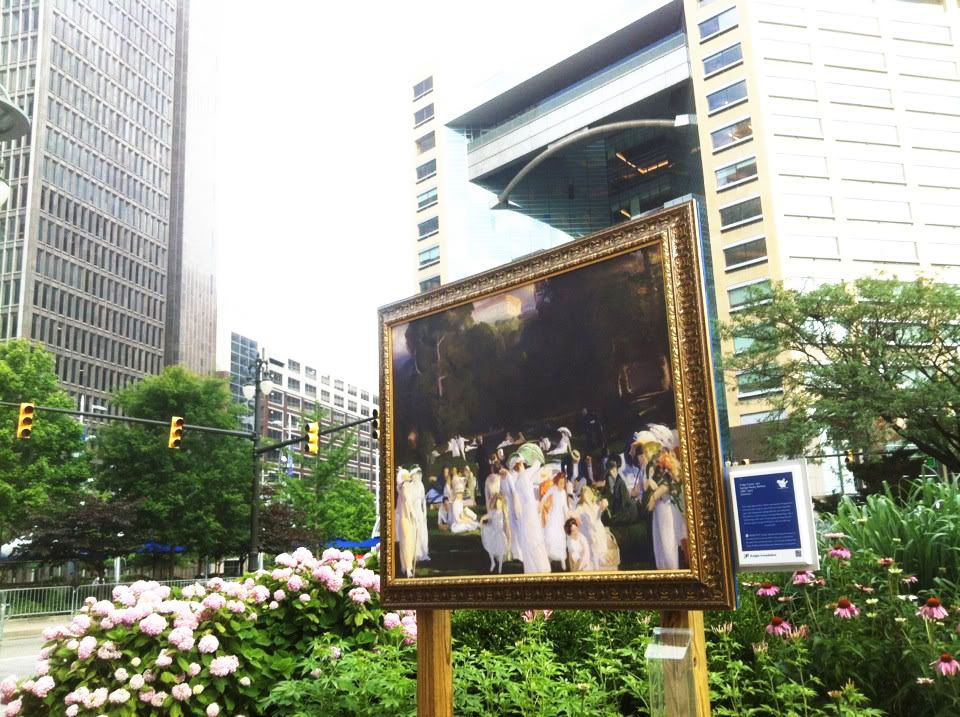 | | |
Cadillac Square, Detroit
| |
The DIA's popular Inside|Out program has just moved its high-quality reproductions of museum masterpieces to thirteen new metro Detroit communities for the summer. The list includes five cities--Clawson, Garden City, Trenton, Troy, Waterford--that have not previously participated in the museum's outdoor art gallery. For returning venues--Canton, Clinton Township, Dearborn, Detroit, Ferndale, Harrison Township, Northville, Royal Oak--a varied mix of reproductions is set in new locations to maintain the element of surprise in seeing art in unexpected places.
In most areas, works are clustered within walking or biking distance of each other, and communities plan activities, such as tours, painting reenactments, and library talks, around the local installation. The DIA offers free museum admission to residents of participating communities on select Family Sundays. For more on specific locations, special activities, and free days, check the Inside|Out page on the DIA's Web site. For videos, photos, or to leave a comment, see the program's Facebook page. The reproductions for this round are on view until September 30.
The John S. and James L. Knight Foundation is sponsoring the program for 2012 and 2013.
Back to top |
|
|
|
|
|
Detroit Institute of Arts
5200 Woodward Avenue
Detroit, Michigan 48202
www.dia.org
313.833.7900
Comments or questions about the newsletter? Please contact us: comments@dia.org
ADMISSION
$8 adults, $6 seniors, $4 children
The museum is free for members
Contact the Membership HelpLine at
313.833.7971 or membership@dia.org
For group sales (15 or more) contact 313.833.1292 or dia.org/grouptours
CATERING & RENTALS
Call 313.833.1925 or
catering@dia.org
|
HOURS
Museum
Mon, Tue CLOSED
Wed, Thur 10 a.m.-4 p.m.
Fri 10 a.m.-10 p.m.
Sat, Sun 10 a.m.-5 p.m.
PARKING
Valet parking is available at the Farnsworth entrance on Fridays, Saturdays, and Sundays, during regular museum hours. The price per car is $8.
Lighted, secure self-parking is available in the Cultural Center parking lot, between John R and Brush, behind the museum.
Ford Free Second Sundays are generously supported by the Ford Motor Company Fund. Next Ford Free Sunday, July 8.
|
CaféDIA
313.833.7966
Wed, Thur 11:30 a.m.-2:30 p.m.
Fri 11:30 a.m.-2:30 p.m., 5-9 p.m.
Sat, Sun 11:30 a.m.-3 p.m.
Kresge Court Coffee Stop
Wed, Thur 10 a.m.-3 p.m.
Fri-Sun 10 a.m.-4 p.m.
Museum Shop
313.833.7944
Open during museum hours
|
|
|
|
|
|










